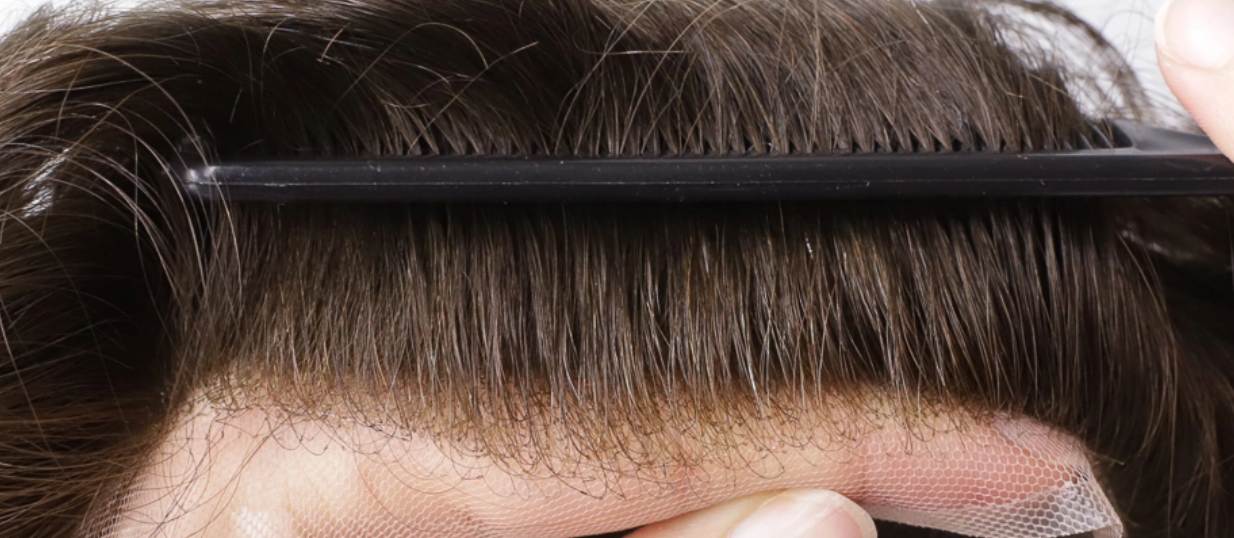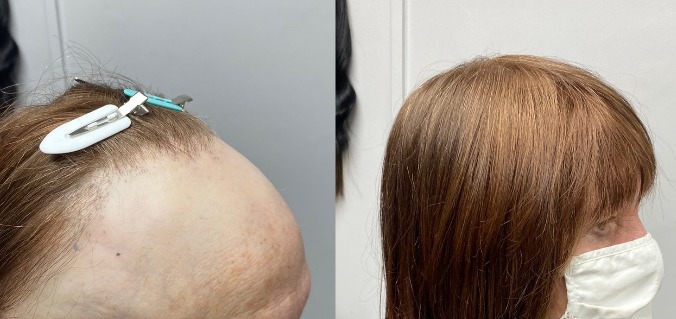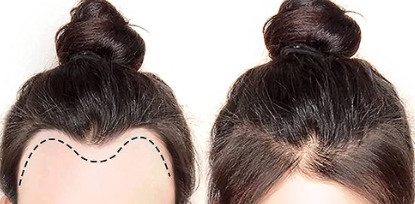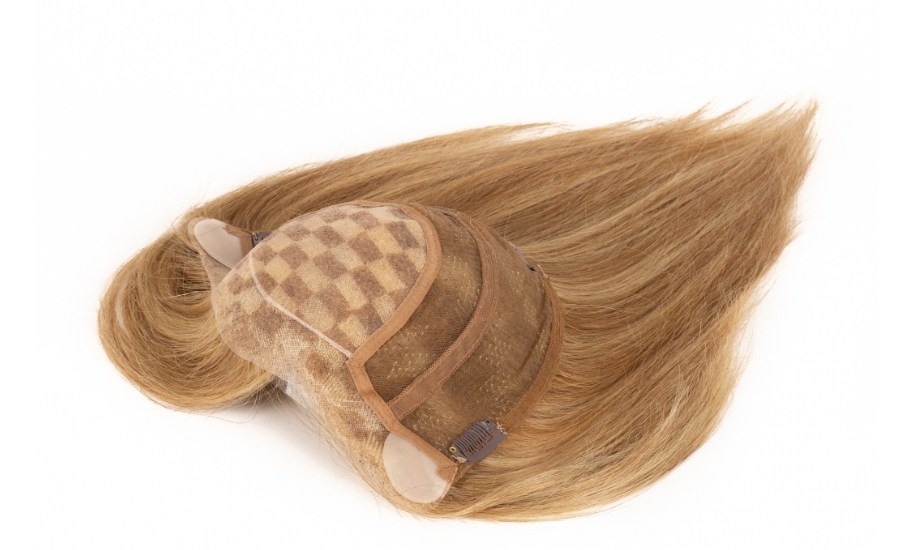Hair Toppers For Frontal Hair Loss

Frontal Fibrosing Alopecia and Hair Toppers as a Solution for Frontal Hair Loss
Table of Contents
What Is Frontal Fibrosing Alopecia?
Frontal Fibrosing Alopecia, or Lichen Planopolaris, is what we’re diving into today. This hair loss condition has a knack for targeting your hairline, and then it sneaks backward. Sometimes, it’s not content with just your scalp—it can make your eyebrows vanish or even affect hair growth across your body.
Now, here’s the thing: it’s more common in older ladies who’ve gone through menopause, but it can also show up in men and younger women. This condition slowly makes your front hairline move backward and makes your eyebrows thinner or disappear altogether.
Why does this happen?
Well, doctors aren’t completely sure yet. They think it’s your body’s own defense system going a bit haywire. Instead of protecting your hair, your immune system ends up attacking your hair roots, causing damage and scars. It’s like friendly fire, but not so friendly for your locks. Researchers are still digging into what triggers all this, but they’re thinking hormones, your family genes, and things around you might play a part.
Dealing with Frontal Fibrosing Alopecia
Now, here’s the deal: There’s no magic fix for this problem. No cure, sorry to say. But don’t give up hope just yet. There are some treatments that can help you deal with it. These treatments won’t make it all go away, but they can make a real difference in how you look and feel. Many people who’ve battled with this, found a solution called Hair Toppers for Frontal Hair Loss. After trying everything under the sun to regrow their hair, they discovered the joy of hair frontal pieces to cover their hair loss.

Amy’s Frontal Hair Loss Journey
I want to rewind about seven or eight years back when I first noticed something odd. There was this tiny patch of hair loss right here by my hairline. I was working a job where I wore sunglasses daily, and I figured maybe the constant rubbing from the shades was causing the hair to vanish. I mean, it was such a slow process that I didn’t really catch on to it right away. See, with Frontal Fibrosing Alopecia, your hair doesn’t just bail out in clumps, so it’s not screaming for attention.
The Quest for a Diagnosis
Fast forward a year, and I moved to a new place. I went to see a hairdresser who’d previously cut my hair, and she freaked out. “You’ve lost so much hair since I last saw you,” she exclaimed. She urged me to see a doctor. So, off I went, and my doc ran a barrage of tests, checking for everything from Lyme disease to vitamin deficiencies, even diabetes. But guess what? All negative. So, it wasn’t as simple as that.
My doctor leaned towards stress as the culprit. I was indeed under a lot of stress at the time, with a demanding job and a chaotic living situation. It seemed like the logical explanation. She reassured me that if stress was the villain, my hair would bounce back. But it didn’t. Months rolled by, and my hair remained scarce.
Finally a Diagnosis of Frontal Fibrosing Alopecia!
Around this point, I noticed that my eyebrows had turned into these red, puffy, and swollen things. Not the best look, I can tell you that. It seemed like inflammation, so I headed to a dermatologist. He diagnosed it as dermatitis and told me to apply dandruff shampoo. I did that, religiously, but it didn’t help one bit. Also, I had cystic acne, and I wanted him to address that too. But nope, he dismissed my acne and essentially gave up on my eyebrows. As you can imagine, I was pretty upset.
So, I sought out another dermatologist for a second opinion. I went in for what was supposed to be a cystic acne consultation, but this dermatologist was more interested in my hair. She glanced at my hair loss, and within seconds, she knew what was up—Frontal Fibrosing Alopecia. I was stunned. How could she figure it out so quickly when my previous doctor had no clue?
To confirm the diagnosis officially, she examined the pattern of my hair loss, the recession of my hairline, and the loss in my eyebrows. She also performed a scalp biopsy—a small sample taken from my scalp, which was sent to a lab for analysis. The results confirmed it: Frontal Fibrosing Alopecia.

Anti-Inflammatory Treatments for Frontal Fibrosing Alopecia
Now, armed with a proper diagnosis, it was time to tackle this head-on. The first step was to reduce the inflammation that was causing the hair loss. I was given fluocinonide to apply topically to my scalp and a steroid cream for my eyebrows to combat the inflammation.
In addition, I was prescribed minocycline, an antibiotic known for its anti-inflammatory properties. And then came the cortisone injections, a series of three sessions over a month. Each session involved four to five injections on each side of my head to tamp down the inflammation. Let me tell you, those injections worked like magic. The redness and inflammation on my scalp were gone, and my hair loss had finally stopped.
Hair Regrowth Treatments for Frontal Fibrosing Alopecia
With the hair loss under control, it was time to try and regrow whatever hair could still make a comeback. I was put on Rogaine to be applied daily. And then, there was Platelet-Rich Plasma (PRP) treatment—a procedure where they draw your blood, spin it to separate the plasma, and then inject that plasma into your scalp. It’s a bit painful, I won’t lie, but they do numb the area before the procedure. But it was worth it because I started seeing results, especially with those tiny baby hairs sprouting around my scalp.
After PRP and some time, we decided to go for a Keralase treatment. This involved six laser sessions, where they ran a laser over your scalp to create microchannels. Then, they apply a topical liquid that seeps into these channels, providing nutrients to your hair follicles. It did help, though we only did one series because, even though I saw progress, it wasn’t a massive transformation.

HAIR TOPPERS FOR FRONTAL HAIR LOSS
Amy tried so many things to get her hair back. It was tough, really tough. But then, guess what? She discovered these amazing hairpieces called hair toppers, and boom! Her life changed. She’s happy now, loving her toppers solution and she is finally feeling like herself again. Confidence? Oh yeah, she’s got loads of it now. And those worries about her hair? Gone. Just gone.
If you’re dealing with frontal hair loss, thinning hair or any other kind of hair loss, you are not alone, believe me. Keep exploring your options, consult specialists, and stay informed about the latest advancements in hair restoration. You will find a solution that will finally give you peace of mind! With this article, I encourage you to discover more and consider the option of wearing Hair Toppers for Frontal Hair Loss.
You are not alone! And there is a solution for you out there!
These statistics highlight the prevalence and significance of female hair loss, shedding light on a commonly overlooked issue in the United States.
| Female Hair Loss Statistics | Percentage / Number |
|---|---|
| Women with thinned or lost hair | 25% |
| Female hair loss due to hormonal changes | 95% (e.g., pregnancy, menopause) |
| Menopausal women with thinning hair | 4 out of 10 |
| Women over age 65 with thinning hair | Over 50% |
| Women with hair loss reporting depression | 29% (NIH study) |
| American women suffering from alopecia | 21 million |
| Women pursuing restoration treatment | 12% (compared to 20% of men) |
| Women with noticeable hair loss by age 60 | 80% |
| Female alopecia patients | 40% of all alopecia cases |
